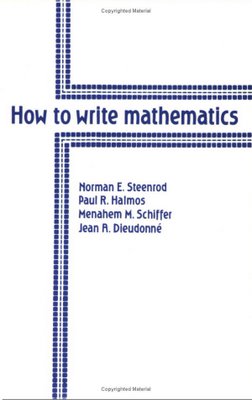I started reading this thin 64 page collection of essays the same week I started another book published under similar conditions. In both this book and "The Computer and the Brain" by John von Neumann, death came too quickly for the authors. If it were not for the widows, it is possible that neither of these of works would have been published. It reminded me that I have a few unfinished works lying around. Recently I have been telling my daughter with regard to her web-based writings, "You are not done with your writing until it is published."
The various authors of "How to Write Mathematics" set out to describe their own personal writing styles, beginning with an admission that there is a lack of consensus on this topic. Indeed, the book closes with a couple of pages by the last author critiquing the advice of the first. On including detailed proofs in your publications, for example, you will find one author prescribing and another proscribing the practice.
The essays were written independently and this shows in the overlap and the contradictions. Whereas I have been highly critical of multi-author books in the past, the approach seems to work in this collection. Recalling my own efforts in writing a book on a topic within another field, I found myself agreeing or disagreeing with the authors on the various points. I was relieved to note that as early as at least three decades ago, authors before me shared identical conflicts with editors and copyreaders.
Based on my limited experience in writing, I had developed a number of half-formed rules of thumb. Given the recommendations of writers more experienced than I as so boldly presented, I am likely to be more aggressive in applying these rules. I would recommend this book to those authors with at least a few writing efforts under their belts. Given the specific nature of the examples in the essays, however, it is likely that only mathematicians will fully appreciate this book.





No comments:
Post a Comment